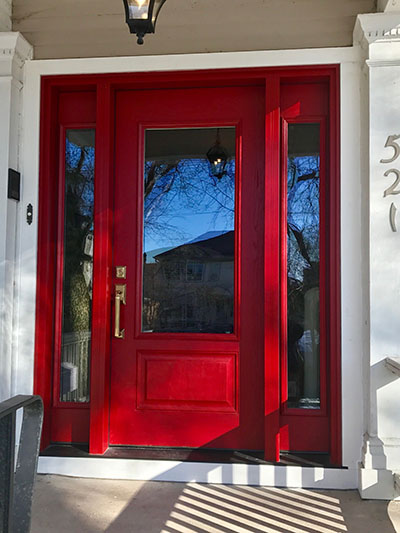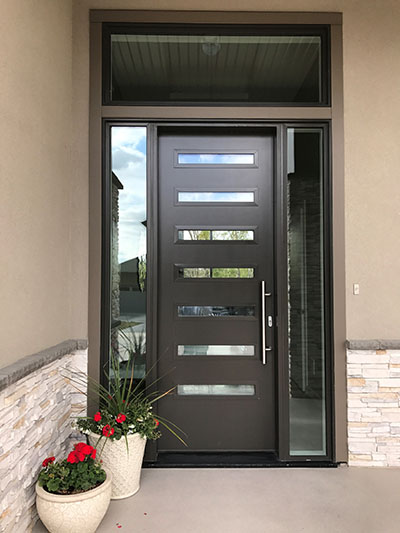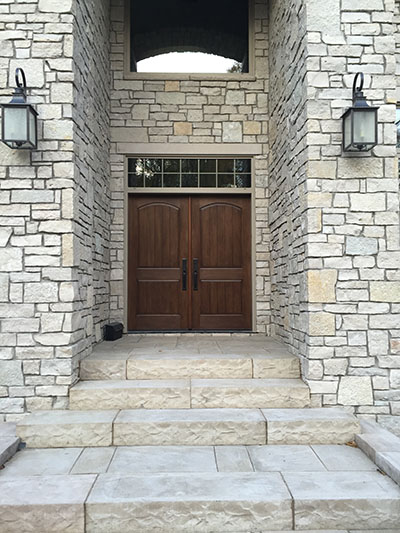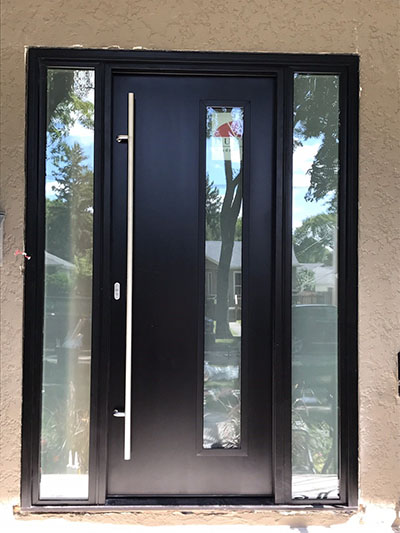Make a Grand Entrance
backby Aynsley Dueck
In a home, the front door is one of the defining architectural features. It can provide a feeling of comfort, warmth, and security. At the same time, it can be bold, distinct, and playful. The beauty is that you can take the design in many directions. Henry Ford’s “you can have any colour, so long as it’s black” has evolved markedly towards customization for individual homes, and individual personalities. It is a real joy to design the front door with each client, because each story and each style is uniquely different. Some have a traditional, or maybe craftsman style home, and they choose decorative glass or a rich wood look. On the other hand, some have a very modern aesthetic, and choose very streamlined styles or strong colours to make the door stand out. If you are considering designing your own “grand entrance”, here’s some inspiration to get you started.
Bold and Colourful
One of the most notable ways to bring out your front entrance is by choosing a bright pop of colour. Crimson red, sunny yellow, and bright orange doors are among the boldest choices. In fact, bold colours are very popular in Europe, and in costal cities to counter the cloudy skies. On the softer size, woodgrain texturing brings a brightness and warmth that also stands out.
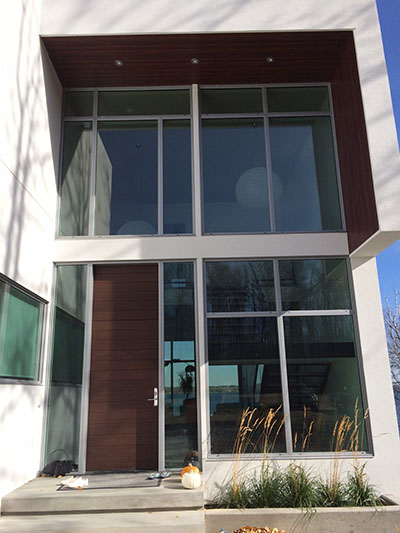
New home featuring an entry of all glass and a towering 12 foot panel.
Look Up
Particularly in new construction, homeowners are inclined to build height into their front entries. There’s an impressive feel to a 10 or 12 foot entrance, or even 14! If you have the ceiling height, explore your options. Height can be achieved with either very tall door panels or transoms, allowing natural light to brighten the space. If you are choosing a tall door panel, consider a multi-point lock, which engages in three places (rather than one) so you can improve air tightness and security. Conversely to height, some homeowners choose to use width, including extra wide styles and sidelites to make the entryway more substantial.
DESIGN TIP:
You can treat your entry door as a separate issue from your windows. It is possible to have the same colour frame on both, but it is not necessary. Grab some colour chips and walk around the exterior and the interior of your home – you may be surprised at how well one colour brings out a tone from your brick outside, or your tiles inside. If needed, you can split-finish the door, meaning one interior colour, and a different exterior colour.
Sleek & Streamlined
In the past, the glass was intricately decorated, including beveled glass, and diamond, curved, or floral shapes. Today, decorative glass is either streamlined, with more straight/geometric lines, or not included in favour of a decorative panel. Panels can allow for a lot of creativity in “custom cut-outs,” meaning different configurations of glass. Instead of a half or 3?4 lite of glass, consider 4 or 5 cut-outs, or even an offset cut-out, balanced with a pull bar. Some architects and designers have been very clever in including stainless steel accents, or simply a bold solid coloured panel, with lots of glass all around.
Light & Privacy
An important consideration is how much light do you want from the front door, but conversely, how much privacy would you like? Decorative glass typically comes with a privacy rating, so compare some styles to get a sense of what will fit your needs. Another option is to add a peephole. If you have the space, add a transom above the door, or opt for glass in the upper portion of the panel, which will nicely shed light without compromising on privacy.
Statement-making Hardware
Once you have narrowed down the style and colour, finish it off with the perfect handle. Nowadays homeowners gravitate towards Satin Nickel (looks like a brushed stainless steel) or an Oil Rubbed Bronze (a very dark brown that works with brown or black). However, if you have a historic style home, don’t be afraid of the traditional finishes such as Antique Brass, which may be the perfect “icing on the cake.”
In terms of shape, the modern doors have very narrow plates and very sleek handles, or conversely, a commercial-looking pull bar. The more traditional doors typically have “gripsets,” where the lock and handle are all on one plate, and are more substantial in size.
DESIGN TIP:
Consider a simple obscured glass as a nice way to balance light and privacy, such as Misted or Sandblasted.
Air tightness and insulation
European-style doors offer some exciting advances on swinging doors, especially for some of Canada’s extreme climates. They typically have more substantial doors, whether they are thicker, which allows for more insulation or higher R-values, or they have stepped edges, which allows for double weatherstripping. Further, they have very heavy duty anti-theft hardware on both sides of the panel. This style of door is still a small percentage of our market, but is gaining great interest from the passive house and net zero housing communities and is very likely the way forward for building better buildings and a healthier environment.
DESIGN TIP:
Consider functionality requirements. As we age, it is easier to push down on a lever rather than twist a knob. Similarly for children, it requires less effort to open the door if it’s a lever style.

